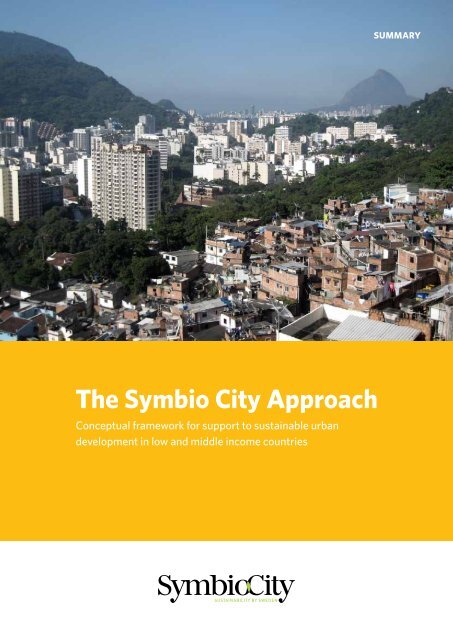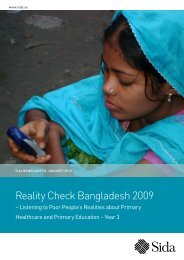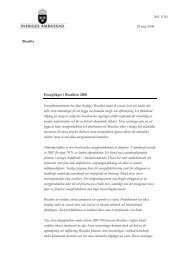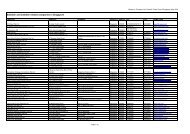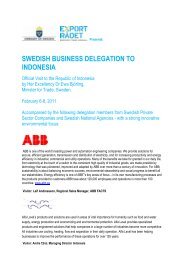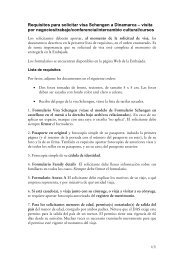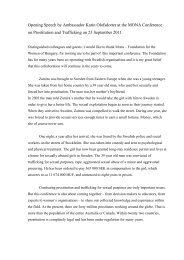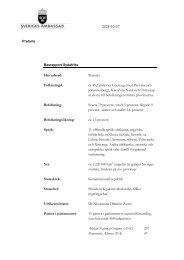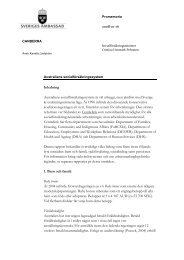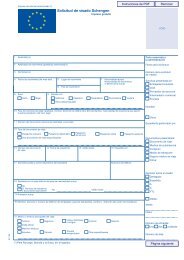The Symbio City Approach - Sweden Abroad
The Symbio City Approach - Sweden Abroad
The Symbio City Approach - Sweden Abroad
Create successful ePaper yourself
Turn your PDF publications into a flip-book with our unique Google optimized e-Paper software.
SUMMARY<br />
<strong>The</strong> <strong>Symbio</strong> <strong>City</strong> <strong>Approach</strong><br />
Conceptual framework for support to sustainable urban<br />
development in low and middle income countries
FIGURE 1. WHO considers traffic to be one of the worst health hazards in cities. <strong>The</strong> image to the left shows a congested urban traffic situation in<br />
Beijing. A new, integrated public transport system, as in Caofeidian Eco<strong>City</strong> (China), could provide citizens with safe, comfortable and affordable<br />
public transportation (image to the right).<br />
<strong>The</strong> urban crisis and its solutions<br />
Since the beginning of this century the majority of the world’s six billion<br />
people have lived in cities. World population may rise from the current 6<br />
to 9 billion people by 2050 and some scenarios predict that 60% of this<br />
population will live in cities by 2030. This urbanization trend is especially<br />
apparent in developing countries or countries in rapid transition.<br />
Urbanisation is inherent in economic and<br />
cultural development and the trends are<br />
universal. Life chances and economic opportunities<br />
are often better in cities, even for<br />
many of the poor and disadvantaged. In spite<br />
of all real and potential opportunities that urbanisation<br />
offers, the common impression has<br />
been that the problems related to urbanization<br />
dominate. Perceived opportunities are seldom<br />
realised and this is especially evident in cities<br />
in the developing world.<br />
How urban growth is managed has enormous<br />
implications on the possibility to avoid potentially<br />
disastrous impacts on climate change. A<br />
number of environmental challenges – most<br />
of them related to climate change – must be<br />
dealt with in cities. <strong>The</strong>se include e.g. natural<br />
and man-made hazards; traffic congestion;<br />
traffic deaths and injuries; air pollution from<br />
industry and traffic; lack of green areas and<br />
biological diversity; deficiencies in existing<br />
waste, water and sanitation systems etc.<br />
Energy supply based on fossil fuels and low<br />
energy efficiency in buildings are often major<br />
causes of environmental problems as CO2<br />
emissions and other kinds of air pollution<br />
contribute to climate change.<br />
All these issues contribute to the urban health<br />
crisis. Hand in hand with urbanisation have<br />
come parasites such as tapeworm, roundworm<br />
etc. that previously were usually confined to<br />
rural areas. <strong>The</strong> growth of the population in<br />
many cities is strongly interrelated with a deteriorating<br />
environment and a wide spectrum<br />
of health hazards.<br />
Urban problems have many sources and<br />
causes: rapid growth in population and area<br />
which is not met by corresponding investments<br />
in services; insufficient technology in<br />
industry; transport increasing in volume and<br />
not environmentally adapted; insufficient<br />
sewage systems causing direct emissions of<br />
waste water from industry and households<br />
into rivers and onto land; unsatisfactory waste<br />
management etc.<br />
This large-scale urban growth – especially<br />
in some areas of Asia and Africa – brings a<br />
pressing need for more holistic planning and<br />
governance of city development, including<br />
environmental system solutions. <strong>The</strong>re is also<br />
an urgent need for improved management and<br />
operations of municipal technical infrastructure.<br />
<strong>The</strong>se issues formed the background<br />
of the Swedish initiative and launch of the<br />
<strong>Symbio</strong> <strong>City</strong> <strong>Approach</strong>.<br />
<strong>The</strong> <strong>Symbio</strong> <strong>City</strong> <strong>Approach</strong> forms a starting<br />
point for further development of methods and<br />
tools concerning sustainable urban development<br />
in developing and transition countries.<br />
One important factor behind the Swedish<br />
initiative is the opportunity to mobilise<br />
the Swedish resource base to contribute to<br />
integrated solutions in close collaboration<br />
between different actors. A number of stakeholders<br />
should be involved in the processes<br />
such as municipalities, other public authorities<br />
at national, regional and local level, institutes,<br />
universities, companies and the extensive<br />
networks of the respective stakeholders.<br />
2 <strong>The</strong> symbio city approach
FIGURE 2. Many cities of the world lack sustainable systems for water and waste management. <strong>The</strong>re is however great potential to obtain<br />
environmental, economic and social benefits by combining systems for water supply & sanitation, waste and energy.<br />
Purpose of the<br />
conceptual framework<br />
Sustainable urban development builds<br />
upon a holistic and integrated approach to<br />
managing economic, environmental and<br />
socio-cultural dimensions to development<br />
within a spatial/physical framework. <strong>The</strong><br />
<strong>Symbio</strong> <strong>City</strong> <strong>Approach</strong> has its main focus on<br />
the urban environment, however with clear<br />
links to the social and economic aspects. <strong>The</strong><br />
primary purpose of the approach is to serve<br />
as a basis for dialogue among stakeholders<br />
regarding sustainable urban development,<br />
aiming at practical and integrated solutions,<br />
including environmental system solutions.<br />
By conducting a sustainability review a<br />
holistic analysis can be made of urban areas<br />
of different scales: city/town level, city<br />
district/town district level, block level. <strong>The</strong><br />
framework is thus intended to be a tool for<br />
reviewing cities’ environmental situation in<br />
a systematic and multidisciplinary manner.<br />
<strong>The</strong> framework emphasises on the methodological<br />
approach to sustainable urban<br />
development, and each situation and context<br />
requires its own specific solution.<br />
By applying this proposed holistic approach<br />
to environmentally sustainable development,<br />
a number of benefits for cities and their<br />
residents can be achieved such as:<br />
• An overview of the city’s environmental<br />
situation including key issues and objectives<br />
for future improvement.<br />
• Win-win situations created by working<br />
with integrated planning of different subsystems<br />
such as energy, water and waste.<br />
• Identification of possible strategies for<br />
short term, medium term and long term<br />
improvement of the environment related to<br />
both economic and social dimensions.<br />
How to use the<br />
conceptual framework<br />
<strong>The</strong>re are three entry points to the conceptual<br />
framework: Working procedures, Subsystems<br />
and their potential synergies and Institutional<br />
factors. <strong>The</strong> three parts are closely interconnected<br />
but each part may also be used<br />
independently in the work of preparing a<br />
sustainability review and analysing projects<br />
and proposals with regard to environmental<br />
planning. In many cases it will be useful to<br />
combine the three parts, and this combination<br />
may be carried out in many different ways.<br />
When planning for a project concerning<br />
specific subsystems such as water, waste and<br />
energy, institutional factors including urban<br />
governance and urban planning are often vital<br />
to the success of the project.<br />
<strong>The</strong> <strong>Symbio</strong> <strong>City</strong> <strong>Approach</strong> promotes the<br />
use of either of the two following analytical<br />
approaches to conduct a sustainability review<br />
in a systematic manner, including all three<br />
entry points.<br />
(1) A multi-disciplinary approach<br />
where a city or city district is analysed from<br />
a number of perspectives in order to identify<br />
synergies between different aspects in the<br />
integrated planning framework.<br />
(2) A sectoral approach where a specific<br />
aspect such as water, waste or transportation is<br />
analysed in detail, for example when a concrete<br />
solution or project proposal already has been<br />
forwarded or suggested. A successive widening<br />
of the scope of the review is promoted, aimed<br />
at identifying potential synergies with other<br />
aspects from the starting-point of one specific<br />
aspect. This approach is often necessary as it is<br />
usually extremely difficult to overcome institutional<br />
barriers for a multidisciplinary approach<br />
in a short term perspective. By working this<br />
way, the mindset of decision-makers may successively<br />
shift in order to embrace the multidisciplinary<br />
approach.<br />
<strong>The</strong> symbio city approach<br />
3
<strong>The</strong> conceptual model<br />
A conceptual model for urban development in developing countries.<br />
SPATIAL<br />
SOCIO-<br />
CULTURAL<br />
ENVIRONMENTAL<br />
HEALTH,<br />
COMFORT,<br />
SAFETY,<br />
LIFE QUALITY<br />
ECONOMIC<br />
SPATIAL<br />
One important characteristic of the model<br />
is a holistic, integrated and multi-disciplinary<br />
approach to urban development. <strong>The</strong><br />
model is an attempt to embrace the complexity<br />
of the urban context, and to make<br />
it possible to manage a number of issues<br />
and relationships of relevance to sustainable<br />
urban development (Figure 3). This<br />
is necessary if potential synergies between<br />
different subsystems are to be utilised<br />
and the likely conflicts between different<br />
issues are to be avoided or managed in a<br />
constructive fashion. A sectoral approach<br />
should be replaced by a multi-disciplinary<br />
approach in order to succeed in solving<br />
combined problems. Incentives should be<br />
developed to promote and facilitate such<br />
integrated approaches.<br />
SPATIAL<br />
SPATIAL<br />
SPATIAL<br />
FIGURE 3. Conceptual model – the holistic approach to sustainable urban development.<br />
In Figure 4 the central part is thus<br />
surrounded by three rings representing<br />
environmental factors, subsystems<br />
and institutional factors. <strong>The</strong> planning<br />
process including a working procedure<br />
(Figure 5) also forms an important part<br />
of the model. 1<br />
INSTITUTIONAL FACTORS<br />
URBAN<br />
GOVERNANCE<br />
SUBSYSTEMS<br />
URBAN FUNCTIONS<br />
URBAN<br />
PLANNING<br />
LEGISLATION<br />
POLICIES<br />
TRAFFIC AND<br />
TRANSPORT<br />
ENVIRONMENTAL FACTORS<br />
AIR<br />
POLLUTION<br />
CLIMATE<br />
CHANGE<br />
ENERGY<br />
FINANCING<br />
RISK<br />
HAZARDS<br />
HEALTH,<br />
COMFORT,<br />
SAFETY,<br />
LIFE QUALITY<br />
NOISE<br />
VIBRATIONS<br />
LAND<br />
MANAGEMENT<br />
BUILDING AND<br />
ARCHITECTURE<br />
RADIATION<br />
HARMFUL<br />
SUBSTANCES<br />
WASTE<br />
CONTAMINATED<br />
LAND WATER<br />
TRAINING<br />
LANDSCAPE<br />
PLANNING<br />
WATER<br />
TECHNOLOGY<br />
PUBLIC-PRIVATE<br />
COOPERATION<br />
FIGURE 4. Conceptual model for a systematic and integrated approach<br />
to urban environment.<br />
1) It is, of course, possible to develop guidelines<br />
focusing on social and/or economic factors with<br />
the same basic approach and philosophy as is<br />
applied here to the environmental field.<br />
4 <strong>The</strong> symbio city approach
6 1<br />
6 1<br />
6 1<br />
5<br />
2<br />
5<br />
2<br />
5<br />
2<br />
4<br />
3<br />
4<br />
3<br />
4<br />
3<br />
FIGURE 5. A cyclical, iterative method of working has many advantages. One example: By putting forward alternative proposals for the improvement<br />
of the environment as early as the first loop, a clearer picture of the relevant aspects that must be considered in more detail in the second and third<br />
loop can be discerned.<br />
Working procedure<br />
<strong>The</strong> cyclical working procedure includes a number of steps for<br />
systematically preparing a sustainability review of a city/town, a city<br />
district/town district or other urban area.<br />
Such a review includes an analysis of the<br />
environmental situation in a specific urban<br />
area as well as ideas and proposals for the<br />
improvement of the environment, with special<br />
consideration of the situation and needs of the<br />
urban poor.<br />
<strong>The</strong> steps described in the working procedure<br />
can also be used for the analysis and evaluation<br />
of projects and proposals, as well as<br />
for dialogue among partners and other<br />
stakeholders concerning sustainable urban<br />
development. <strong>The</strong> working procedure also<br />
includes tools for the further development<br />
and improvement of approaches, policies,<br />
programmes and projects on regional<br />
and local levels.<br />
<strong>The</strong> sustainability review, or the project, is<br />
intended to be developed and/or scrutinised<br />
in three loops. In the first loop there is a<br />
focus on steps 1–2, but overall objectives and<br />
preliminary proposals for the improvement<br />
of the environment are also developed or<br />
reviewed. In the second loop the main focus<br />
is on steps 3-4. In the third loop most work is<br />
concentrated on steps 5-6. Depending on the<br />
complexity of the project, further loops may<br />
be considered.<br />
By putting forward alternative proposals /<br />
scenarios for the improvement of the environment<br />
already during the first project loop,<br />
identification of relevant factors and aspects<br />
that need to be considered in more detail can<br />
be discerned.<br />
Applying the cyclical approach provides an<br />
opportunity to delimit the scope of work to<br />
the aspects identified relevant at an early stage<br />
of the review and development process. In<br />
a more linear process, there is a risk that the<br />
scope of work becomes too comprehensive,<br />
thus making it difficult to identify and address<br />
the relevant issues at an early stage.<br />
<strong>The</strong> main steps in the cyclical working<br />
procedure are:<br />
Step 1 Define and organise the<br />
sustainability review<br />
Step 2 Make a diagnosis of the<br />
current situation<br />
Step 3 Specify key issues<br />
and objectives<br />
Step 4 Develop alternative proposals<br />
Step 5 Analyse anticipated,<br />
possible impacts<br />
Step 6 Choose a strategy for<br />
implementation and follow-up<br />
<strong>The</strong> symbio city approach<br />
5
As the <strong>Symbio</strong> <strong>City</strong> concept emphasises on the methodological approach,<br />
each of the 6 steps are described in general terms. <strong>The</strong> loops as presented are<br />
generic, thus the process and the loops will have to be adjusted to the specific<br />
conditions of each and every situation or project.<br />
5<br />
STEP 1 STEP 2<br />
STEP 3<br />
6 1<br />
6 1<br />
4<br />
3<br />
2<br />
Define and<br />
organise the<br />
sustainability<br />
review<br />
5<br />
4<br />
3<br />
2<br />
Make a diagnosis<br />
of the current<br />
situation<br />
5<br />
6<br />
4<br />
1<br />
3<br />
2<br />
Specify<br />
Objectives<br />
A sustainability review is a holistic<br />
analysis of urban areas on different<br />
scales: city or town level, city district or<br />
town district level and block level. <strong>The</strong><br />
objective of the review is to achieve a<br />
better understanding of the environmental<br />
situation. Hereby, it is also possible to<br />
identify alternative proposals / scenarios<br />
for development, as well as, to discern<br />
and delimit possible and relevant future<br />
projects for sustainable urban development.<br />
Well-thought out planning and<br />
organisation of the review is one of the<br />
keys to its success. In step 1 the process<br />
is initiated by the formulation of aim and<br />
main objectives of the review, as well as<br />
an organization plan combined with a<br />
time schedule. <strong>The</strong> review activities are<br />
here described in relationship to each<br />
other and with respect to environmental<br />
issues. A list of relevant stakeholders<br />
should be drawn up as part of the organisation<br />
plan.<br />
<strong>The</strong> importance of involving the population<br />
– including the poor<br />
– in the process in general, and in the<br />
steps of the review in particular, must be<br />
underlined. <strong>The</strong> competence and creative<br />
resources of the residents of poor urban<br />
settlements are often underestimated,<br />
for example with regard to knowledge<br />
of the population structure, the status of<br />
infrastructure, risk situation etc. <strong>The</strong>re<br />
are also opportunities for the residents<br />
to contribute with their own efforts to<br />
improve the situation in order to reduce<br />
investment and<br />
operating costs.<br />
<strong>The</strong> environmental situation of the<br />
urban area in question should always be<br />
mapped in order to identify conditions,<br />
problems and qualities. Urban environmental<br />
problems in particular affect the<br />
poorest and most disadvantaged sections<br />
of the population who often experience<br />
maximum exposure to air and water<br />
pollution, lack of community services and<br />
poor access to healthcare. An overall understanding<br />
of the environmental situation<br />
in an urban context may be achieved by<br />
the application of e.g. a SWOT-analysis.<br />
Environmental problems can also be<br />
described in more detail with regard to<br />
different kinds of emissions, disturbances<br />
and frequency.<br />
<strong>The</strong> consequences of environmental<br />
problems should be observed and noted<br />
separately e.g. respiratory diseases due<br />
to air pollution, high death rates amongst<br />
children due to waterborne diseases<br />
or high cost of water treatment due to<br />
polluted water sources. When seeking to<br />
address these problems and consequences<br />
it is important to look for the sources<br />
and causes of environmental problems.<br />
Logical Framework <strong>Approach</strong> (LFA) or<br />
the “problem tree” are useful methods for<br />
these analysis.<br />
Overall environmental objectives should<br />
reflect the basic ambition as concerns the improvement<br />
of the environment in a long term<br />
perspective. Key objectives for the environment<br />
should be formulated as a starting-point<br />
for the development of alternative proposals<br />
for the improvement of urban areas. It is<br />
proposed that objectives should be formulated<br />
on the following three levels as concerns the<br />
project situation: main objectives (environmental<br />
quality objectives) for example<br />
improved aquatic environment. One sub-objective<br />
related to this main objective is water<br />
saving and an example of a target is “total<br />
potable water consumption 100 litres/person<br />
and day”. Other examples of formulation of<br />
objectives are presented in the manual. Key<br />
issues regarding the environment for a certain<br />
area may be defined based on the analyses in<br />
Step 2 (SWOT, LFA, problem tree etc.). 2<br />
2) SWOT = Strengths, Weaknesses,<br />
Opportunities, Threats<br />
6 <strong>The</strong> symbio city approach
5<br />
STEP 4<br />
6 1<br />
6 1<br />
4<br />
3<br />
2<br />
Develop<br />
alternative<br />
proposals<br />
5<br />
4<br />
3<br />
2<br />
STEP 5<br />
Analyse<br />
Impacts<br />
5<br />
6<br />
4<br />
1<br />
3<br />
2<br />
STEP 6<br />
Implementation<br />
and follow-up<br />
<strong>The</strong> diagnosis of the current situation,<br />
as well as the formulation of objectives,<br />
serves as a basis for identifying alternative<br />
proposals to solve the environmental<br />
problems. As the problems often are<br />
complex there will probably be a number of<br />
alternative solutions.<br />
A possible set of alternatives, focusing on<br />
synergies between different subsystems,<br />
should be identified in order to take the<br />
proper measures.<br />
Since the situation often changes quickly,<br />
and any solution or investment should be<br />
relevant for several years, it is particularly<br />
important to choose flexible solutions, not<br />
least in developing countries.<br />
<strong>The</strong> first choice should be to develop<br />
alternative proposals aimed at prevention<br />
and intervention using such measures as<br />
redevelopment of housing areas, workplaces<br />
and services or investment in clean technology<br />
within heavy industry. <strong>The</strong> secondary<br />
choice should be to mitigate the existing<br />
situation by measures for improving existing<br />
urban areas or existing technology. One<br />
dilemma related to mitigation is that this<br />
type of strategy may cause an unfavourable<br />
overall environmental situation to be made<br />
permanent.<br />
When working in a future-oriented<br />
manner with both the renewal of existing<br />
urban areas and the planning of new areas,<br />
“back-casting” can be used as a method to<br />
secure small-scale stepwise improvements<br />
which are coherent with a long-term<br />
sustainable solution.<br />
<strong>The</strong> economic, social and environmental<br />
impacts of alternative proposals and<br />
solutions should be investigated and<br />
described in order to obtain a basis for<br />
choice of one alternative or a combination<br />
of several alternatives. <strong>The</strong> analysis<br />
of impacts, e.g. by applying Strategic<br />
Environmental Assessments (SEA) 3 and<br />
Environmental Impact Assessments (EIA) 4 ,<br />
is important to develop holistic and innovative<br />
proposals. Consequently, the inclusion<br />
of an impact analysis in the sustainability<br />
review is recommended. <strong>The</strong> focus of these<br />
guidelines is on the assessment of the environmental<br />
impacts of alternative solutions<br />
with special regard to the situation of the<br />
urban poor. Social and economic impacts<br />
are no less important to analyse – however<br />
tools for this analysis are provided in other<br />
governing documents.<br />
<strong>The</strong> analysis of impacts in Step 5 results in<br />
the recommendation of a preferred proposal,<br />
as well as a further strategy for the implementation<br />
in a long term, medium term<br />
and short term perspective. <strong>The</strong> proposals<br />
and strategies developed in a sustainability<br />
review may consist of a combination of<br />
elements from several alternatives, or one<br />
main alternative with some additions from<br />
other alternatives assessed in Step 5.<br />
As a follow-up to Step 4, an essential part of<br />
this phase is to define a number of projects<br />
focused on synergies between different sub<br />
systems for further development and implementation.<br />
It is also important to continuously<br />
assess the final result of the planning<br />
process i.e. the qualities and problems<br />
related to the urban physical environment.<br />
For follow-up of the impact of an intervention<br />
proposed in a review, the Logical<br />
Framework <strong>Approach</strong> (LFA) is a useful tool.<br />
3) SEA = Strategic Environmental Assessment<br />
4) EIA = Environmental Impact Assessment<br />
<strong>The</strong> symbio city approach<br />
7
Specific subsystems and<br />
their potential synergies<br />
A number of specific subsystems have been identified as being especially<br />
important with regard to substantial improvements of the urban environment.<br />
A number of specific subsystems have been<br />
identified as being especially important with<br />
regard to substantial improvements of the<br />
urban environment.<br />
INSTITUTIONAL FACTORS<br />
URBAN<br />
GOVERNANCE<br />
SUBSYSTEMS<br />
URBAN FUNCTIONS<br />
Examples of such subsystems are Urban<br />
Functions 5 , Energy, Waste Management,<br />
Water Supply and Sanitation, Traffic and<br />
Transport, Landscape Planning, Sustainable<br />
Architecture. Institutional factors are also of<br />
crucial importance for the mitigation of environmental<br />
problems. For progress to be made,<br />
a city needs to address both its institutional<br />
settings and the performance and infrastructure<br />
of one or more subsystems.<br />
FINANCING<br />
LEGISLATION<br />
POLICIES<br />
BUILDING AND<br />
ARCHITECTURE<br />
TRAFFIC AND<br />
TRANSPORT<br />
RISK<br />
HAZARDS<br />
RADIATION<br />
ENVIRONMENTAL FACTORS<br />
AIR<br />
POLLUTION<br />
CLIMATE<br />
CHANGE<br />
HEALTH,<br />
COMFORT,<br />
SAFETY,<br />
LIFE QUALITY<br />
NOISE<br />
VIBRATIONS<br />
HARMFUL<br />
SUBSTANCES<br />
URBAN<br />
PLANNING<br />
ENERGY<br />
WASTE<br />
LAND<br />
MANAGEMENT<br />
<strong>The</strong> sustainability concept itself requires<br />
that urban functions, municipal services and<br />
infrastructure are available to all, at an affordable<br />
cost. It is vital that urban planning, sector<br />
planning and interventions in these fields are<br />
made with poor people’s conditions and<br />
needs in focus, and that all inhabitants are<br />
invited to participate in the decision and<br />
planning processes.<br />
TRAINING<br />
LANDSCAPE<br />
PLANNING<br />
CONTAMINATED<br />
LAND WATER<br />
PUBLIC-PRIVATE<br />
COOPERATION<br />
WATER<br />
TECHNOLOGY<br />
FIGURE 6. An overview of subsystems discussed in this section.<br />
Financing of urban environment interventions<br />
are high and require special attention.<br />
Local authorities must be involved and<br />
strengthened in order to manage both<br />
investments and the long term operation of<br />
such interventions. Also in this respect it is<br />
vital from a sustainability viewpoint that<br />
the inhabitants’ ability to pay is taken into<br />
consideration when formulating designs,<br />
fees, connection charges, organisation of<br />
operations etc.<br />
One general remark regarding the technology<br />
of subsystems is the option for successive development<br />
of small-scale, low-tech solutions<br />
to medium large and large scale respectively<br />
medium-tech and high-tech. <strong>The</strong> opportunities<br />
for future improvement and extension<br />
should always be considered, see Figure 7.<br />
5) Examples of urban functions include housing,<br />
industry, service functions, recreational and cultural<br />
functions etc. This can be considered as a subsystem<br />
as it is very important to examine the spatial, environmental,<br />
social and economic requirements of<br />
such functions as a basis for the development of both<br />
technical solutions and integrated city planning.<br />
Essential synergies between<br />
different subsystems<br />
In all planning and design situations related to<br />
sustainable urban planning it is essential to take<br />
into consideration potential synergies between<br />
subsystems. However, synergies between<br />
different institutional factors and between<br />
institutional factors and subsystems are as<br />
important, and should also be identified in the<br />
review process.<br />
Figure 6 illustrates the overall holistic<br />
approach applied in the framework, and<br />
indicates that each subsystem has interfaces<br />
with other subsystems. Below follows<br />
a description of some examples of this, i.e.<br />
how different subsystems are linked and<br />
interdependent, how synergies can be achieved<br />
and sub-optimisation avoided. Traditionally,<br />
a project or intervention has considered one<br />
system at a time, leading to sub-optimisation.<br />
When examining one specific system it is<br />
always important to try to find links to other<br />
systems in order to develop optimal solutions.<br />
Often there is not only a lack of synergies but<br />
rather conflicts of interest between different<br />
subsystems. Sometimes hard facts prove that<br />
what is good for one area of planning is contraproductive<br />
to the needs of another.<br />
Synergies... between energy, waste<br />
and water resources management<br />
and landscape planning<br />
<strong>The</strong>re is great potential to obtain environmental,<br />
economic and social benefits by combining<br />
systems for water supply and sanitation,<br />
waste and energy. Organic waste from<br />
restaurants and grocery shops as well as from<br />
households, toilet waste, sludge from septic<br />
tanks or wastewater treatment plants and<br />
manure from agriculture adjacent to a town,<br />
can be utilised for the production of biogas in<br />
a biogas reactor. <strong>The</strong> digested biogas contains<br />
methane, which can be used for heating,<br />
cooking and electricity production or, after refining,<br />
as fuel for vehicles. Depending on the<br />
quality, the residue can be used as fertilizer in<br />
agriculture. An alternative technology is the<br />
composting of the same waste material.<br />
8 <strong>The</strong> symbio city approach
TECHNOLOGICAL LEVEL<br />
high<br />
med.<br />
low<br />
LONG TERM<br />
MEDIUM TERM<br />
SHORT TERM<br />
PILOT PROJECT STRATEGY<br />
RAPID TRANSFORMATION<br />
STRATEGIC<br />
CHOICE<br />
HORISONTAL STATEGIES<br />
Integrated Development Plan<br />
– Buffalo <strong>City</strong> Municipality<br />
<strong>The</strong> Integrated Development Planning<br />
process in Buffalo <strong>City</strong> (the IDP process) was<br />
conducted in a unique situation of historical<br />
transition and a new, emerging identity for the<br />
municipality. Within an overall sustainability<br />
framework environmental issues were subject<br />
to an environmental analysis including a<br />
community needs assessment, an overview<br />
of environmental factors and key findings.<br />
As environmental priority issues, solid waste<br />
management as well as water, soil and air<br />
pollution were identified. An environmental<br />
development framework was developed<br />
including short and long term objectives,<br />
strategies, programmes and prioritised<br />
projects.<br />
small<br />
Synergies…Planning of public<br />
transport and traffic systems with<br />
regard to the location of urban<br />
functions such as industry, offices,<br />
service functions and housing<br />
Planning for integrated land use for different<br />
urban functions should be closely coordinated<br />
with the planning of the transportation system<br />
in order to reduce the need for, and needs of,<br />
transportation. It is also a prerequisite for the<br />
introduction and development of efficient<br />
public transport systems in a town or city.<br />
Urban density for different functions has a<br />
significant effect on overall transport patterns<br />
and intensity.<br />
Developing an urban pattern with higher<br />
urban density along transportation corridors<br />
is an efficient way of promoting travel<br />
by public transport. This is a method of<br />
counteracting “urban sprawl”, i.e., choosing<br />
peripheral locations for commerce, offices<br />
and housing where land is cheaper.<br />
medium<br />
URBAN TECHNOLOGICAL SCALE<br />
large<br />
FIGURE 17. Technological solutions may be systematised in three dimensions:<br />
technological level, urban scale and time dimension.<br />
Synergies... Layout of buildings<br />
with regard to microclimates and<br />
surrounding landscape<br />
<strong>The</strong> well thought-out layout of buildings is an<br />
efficient method of optimizing opportunities<br />
of using solar energy for heating, cooling<br />
and electricity and minimising the negative<br />
impact on energy demand caused by wind<br />
exposure. Prerequisites for optimal adaptation<br />
of buildings to different sites will benefit<br />
from farsighted urban planning, but also from<br />
urban governance promoting the development<br />
of good relationships between public<br />
authorities and private developers.<br />
Examples: Integrated master<br />
planning of cities and districts<br />
Integrated master planning offers great opportunities<br />
of working systematically with<br />
the synergies of many subsystems in order<br />
to take advantage of environmental, but also<br />
social and economic, benefits. Two examples<br />
on <strong>City</strong> District level from South Africa and<br />
China are presented below.<br />
Conceptual Master Plan for a green<br />
housing district in Wuhai, Inner<br />
Mongolia, China<br />
<strong>The</strong> proposed conceptual Master Plan for<br />
Wuhai green housing district constitutes a<br />
starting-point for discussion on how Swedish<br />
knowledge, services and products can be<br />
utilized within the Sino-Swedish Initiative.<br />
<strong>The</strong> Master Plan proposes resource efficient<br />
land-use patterns including a high quality,<br />
economic public transportation system, a<br />
network of green corridors and careful design<br />
of the waterscape. An energy strategy is integrated<br />
into the proposal including measures<br />
for combining energy efficiency on the block<br />
and building level with renewable energy<br />
supply. An eco-cycle model, which takes<br />
into consideration synergies between energy,<br />
waste, wastewater and storm water, is also an<br />
integral part of the proposal.<br />
<strong>The</strong> symbio city approach<br />
9
Institutional factors for<br />
sustainable solutions<br />
Well-functioning institutional frameworks are crucial<br />
for improvement of the urban environment and include a<br />
wide range of aspects.<br />
Functional institutional frameworks are fundamental to achieve<br />
sustainable solutions. Clear objectives for the environment – expressed<br />
in legislation and policies – combined with good urban governance,<br />
visionary spatial planning and well-thought out land management are,<br />
e.g of considerable importance in order to promote integrated land use<br />
and transport planning as well as integrated planning of water, waste<br />
and energy. Hence, institutional arrangements often are of crucial<br />
importance for achieving synergies between different technical subsystems.<br />
Institutional deficiencies may often delay evident solutions to<br />
environmental problems and consequently<br />
cause new, attendant problems.<br />
<strong>The</strong>re are a wide range of institutional factors to consider in the development<br />
process. Some of the more important aspects are e.g.; legislation<br />
and its implementation, knowledge, capacity and decision-making<br />
power in relevant authorities, organisational structures, communication<br />
and coordination between different actors, transparency, participation<br />
of a wide range of stakeholders in assessing priorities and ensuring<br />
accountability. A more elaborated description of some institutional<br />
factors are described below:<br />
GOOD URBAN<br />
GOVERNANCE<br />
SPATIAL<br />
PLANNING<br />
SYSTEMS FOR<br />
LAND MANAGEMENT<br />
LEGISLATION<br />
& POLICIES<br />
Good urban governance is<br />
extremely important as it<br />
embraces the management<br />
and administration of financial,<br />
economic, technical, organisational,<br />
human and other<br />
resources. Good governance in<br />
combination with urban planning<br />
and the management of subsystems,<br />
are necessary components<br />
for the improvement of the urban<br />
environment. <strong>The</strong> definition of<br />
good governance according to<br />
the World Bank is: ”Predictable,<br />
open and enlightened policy<br />
making, a bureaucracy imbued<br />
with professional ethos acting<br />
for the public good, the rule of<br />
law, transparent processes, and a<br />
strong civil society participating<br />
in public affairs”.<br />
Spatial planning can be defined<br />
as the spatial coordination of all<br />
types of land use for both urban<br />
and rural areas. In sustainable<br />
urban development, the interplay<br />
between urban and rural areas is<br />
so important that spatial planning<br />
has been chosen as the main term<br />
to be utilised in this context.<br />
Spatial /urban planning may be<br />
used as a tool for coordinating<br />
different stakeholders, interests<br />
and factors in the development<br />
process in combination with a<br />
public consultation process and<br />
transparent decision making<br />
and governance. Good examples<br />
of this are the IDP processes<br />
in South Africa or the comprehensive<br />
planning processes in<br />
Swedish municipalities.<br />
Systems for land management<br />
should be developed in direct<br />
relationship with urban planning.<br />
Key issues for the poor are<br />
transparency of land information<br />
systems and taxation for<br />
propoor land management. In<br />
order to improve the situation of<br />
the poor, small plots, mixed land<br />
use, affordable infrastructure and<br />
affordable land for housing should<br />
be observed in land legislation<br />
and policies. Land and housing<br />
markets should also be made<br />
more effective, which also contributes<br />
to economic development.<br />
“If public land is not available for<br />
current and future needs, the local<br />
authority should acquire reserves<br />
of land for urban expansion. This<br />
would allow the municipality to<br />
sell some plots at market prices<br />
to other developers.” 6<br />
Legislation and policies regarding<br />
the urban environment are<br />
powerful tools for enforcing<br />
improvements for the urban poor<br />
and other inhabitants. Overall<br />
objectives integrated into legislation<br />
and policies regarding the<br />
urban environment on national<br />
and regional level should be the<br />
starting-point for the formulation<br />
of planning and building codes<br />
and regulations on the local level.<br />
6) Tannerfeldt & Ljung pp 97-98.<br />
10 <strong>The</strong> symbio city approach
Arenas for public participation in sustainable urban development.<br />
Illustration: sweco<br />
Evaluation meeting in the Caofeidian Eco<strong>City</strong> project in 2008.<br />
Photo: Ulf Ranhagen<br />
PROPER<br />
FINANCING<br />
PUBLIC & PRIVATE<br />
COOPERATION<br />
PUBLIC<br />
PARTICIPATION<br />
EDUCATION, TRAINING<br />
& INFORMATION<br />
Arranging proper financing is<br />
an essential requirement for<br />
planning and implementation of<br />
urban environmental measures.<br />
Expert advice should be contracted<br />
from the beginning of<br />
the process in order to provide<br />
a comprehensive and objective<br />
overview of the financial requirements,<br />
as well as funding and<br />
risk capacity available, and<br />
to mobilize the best possible<br />
combinations of different<br />
financing resources and develop<br />
a financing plan. In doing so, it is<br />
important to bear in mind several<br />
limiting factors for municipalities<br />
and other actors involved.<br />
In order to achieve sustainability<br />
in connection with both new and<br />
existing cities and towns it is<br />
important to develop continuous<br />
cooperation between planning<br />
authorities and private enterprise.<br />
<strong>The</strong>re should be incentives<br />
for small business units within<br />
different kinds of town district<br />
to become involved in the<br />
small-scale transformation of<br />
urban areas. At the same time,<br />
top competence in different<br />
fields of consultancy as well as<br />
manufacturing companies with<br />
innovative sustainable products<br />
should be involved in large-scale<br />
projects, for example as regards<br />
new infrastructure.<br />
Achieving public involvement and<br />
participation in efforts to improve<br />
the environment is crucial for<br />
both short term and long term<br />
success. It is important to inform<br />
the residents in an area in the<br />
early phases of preparation, and<br />
to establish mechanisms for<br />
taking their needs and preferences<br />
into account in the planning,<br />
implementation and follow-up<br />
of measures. While it is often<br />
not practically feasible to expect<br />
involvement from everybody in<br />
every step of the activities, there<br />
are usually representative bodies<br />
in informal settlements which can<br />
be consulted.<br />
Education, training and dissemination<br />
of information are of basic importance<br />
for the increase of public<br />
awareness regarding urban and<br />
environmental issues. <strong>The</strong> development<br />
of learning programmes is<br />
especially important for the future,<br />
programmes that include not only<br />
technical knowledge on specific<br />
aspects, but also on the holistic<br />
and integrated system approach.<br />
AUTHORS: This report summary has been written by a working group consisting of Ulf Ranhagen (main author), Karin Billing, Hans Lundberg and Tina Karlberg (coauthors)<br />
on behalf of Sida INEC/Urban, represented by Tomas Nyström and Lars Eklund. GRAPHIC DESIGN: Press Art. PRINTING: Edita, 2007. <strong>The</strong> revised version with<br />
focus on China has been compiled by Ulf Ranhagen(main author), Tina Karlberg and Olav Heinmets in june 2010. ART NR: SIDA38112en DOWNLOAD: <strong>The</strong> full report (draft<br />
version),”<strong>The</strong> Sustainable <strong>City</strong> <strong>Approach</strong>”, can be downloaded as a pdf-document at www.sida.se/publications<br />
<strong>The</strong> symbio city approach<br />
11
Version: March 2011 Cover Photo: Ulf Ranhagen<br />
<strong>The</strong> <strong>Symbio</strong> <strong>City</strong> <strong>Approach</strong> is an initiative launched by the Swedish Government to promote<br />
sustainableurban development world wide. <strong>The</strong> Swedish Association of Local Authorities<br />
and Regions (SALAR) and its subsidiary SKL International has been commissioned by Sida to<br />
foster and develop the <strong>Symbio</strong> <strong>City</strong> <strong>Approach</strong> between 2010 – 2013. Contact persons: Mr Paul<br />
Dixelius (Project Manager), Ms Lena Nilsson (Project Coordinator), Mr Klas Groth (Urban<br />
Advisor), Prof. Ulf Ranhagen (Senior Advisor).<br />
SKL International<br />
118 82 Stockholm<br />
<strong>Sweden</strong><br />
+46 8 452 7000<br />
www.sklinternational.se


